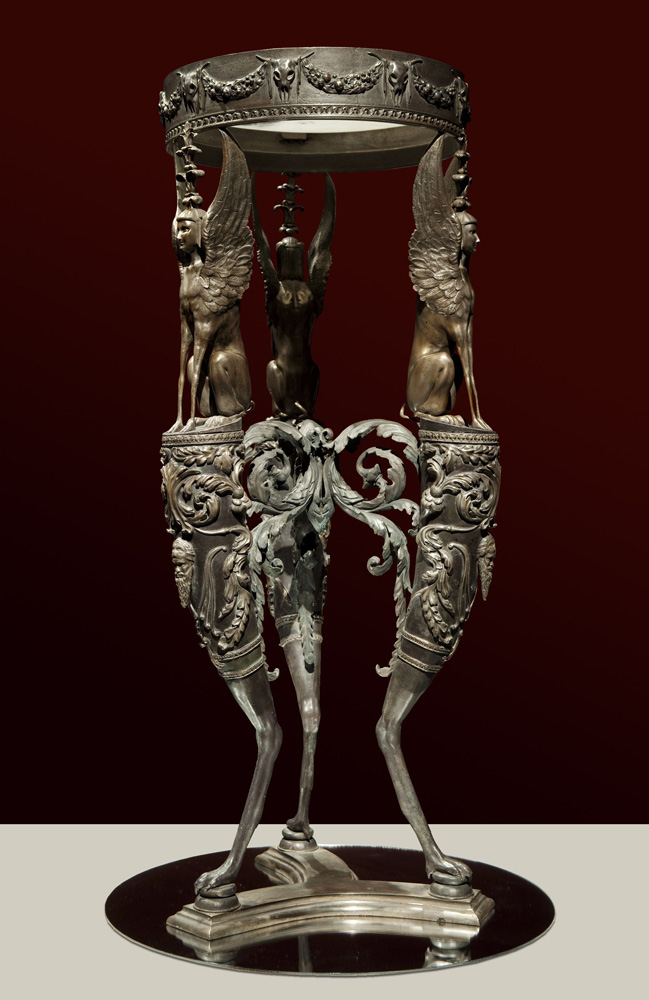Piranesi’s print is based on a tripod from 1st or 2nd century AD said to have been discovered in the scavi of the temple of Isis in Pompeii in the 1760s. The original model for Piranesi’s print was not the tripod itself but a drawing by Vincenzo Brenna. (later renowned for fraud and embezzlement when working in Russia). Brenna had been commissioned by Lodovico Mirri, under the auspices of Pope Clement XIII, to survey Roman relics together with the Pole, Franciszek Smuglewicz. Brenna’s survey was a theatrical conception of antiquity, and this tripod is a clear example of the Roman aesthetic of appropriating influences, later championed by Piranesi. The citation at the top of the print attributes this tripod to the collection of the King of Naples in Portici. It is now in the collection of the Museo Nazionale in Naples. Piranesi’s design differs in several subtle but significant ways from the classical tripod. Piranesi’s overall proportions emphasise the vertical. The position of the sphinx/harpy is improved; the three legs are not joined by a central bar; the pedestal is composed of two intersecting arcs; and the frieze of skulls and garlands is altered. Yet its general composition clearly quotes the original source. Piranesi’s approach to Antiquity was more imaginative than the conventional practice of restrained recording and precise restoration that is common practice today. In Diverse Maniere he urged the modern designer to emulate what he saw as the creative fertility of Roman antiquity by freely combining various motifs from the past to produce works of striking originality. He advocated connoisseurship and ‘improvement’ over slavish imitation of an original, which may contain inferior understanding and craftsmanship. Now, 232 years later, Factum Arte and a diverse team of artisans, both digital and physical, have taken Piranesi’s print as a starting point. New technologies and software have been used to digitally model the object, three dimensional output technologies have been used to transform these virtual designs into physical forms, and traditional craft skills have been used to make it in bronze and alabaster. New tools and technologies now help us to see more, and to see differently, at every stage of recording, making, studying and understanding. The starting point for interpreting Piranesi’s print as a three-dimensional object is to understand his approach to design and making. A central theme in his writing is to assert the importance of a speculative and unfettered imagination to defy the ‘tyranny of theory’. It was of paramount importance for Piranesi to give free rein to his inquisitive mind and his fertile imagination, both in responding to antiquity and in designing new objects. The ‘tyranny of theory’ refers to a particular conception of the Graeco-Roman debate, which used Platonic ideas to support the supremacy of Greek sculpture and architecture as an embodiment of a single, pure, abstracted truth. For Piranesi this reductive approach was anathema, and he vigorously asserted that its over-simplification of the creative process misrepresented the achievements of the Romans and, by extension, the creative urge itself. Piranesi’s famous phrase Col sporcar si trova can be translated as: ‘By messing about, one discovers’. Messing about suggests excess, or undirected play; but it is also an acceptance of the tolerance required for any system to work. Dirt, disorder and noise are all intrinsic to the process of imaginative interpretation. These elements are all inherent in physical touch and the act of making. By messing, Piranesi did more than assemble ideas: he took ideas, gave them form, and in so doing he defied the emerging tyranny of the aesthetic theory of Greek purity. Piranesi was a Venetian shaped by contemporary Rome and by his knowledge of the ‘antique’, which equally embraced Egyptian, Etruscan, Greek and Roman remains. Many of these remains were being discovered in the mid‑C18th on the Italian peninsular. He was fascinated by how the past and the present merge when you engage with an object. Piranesi worked hard on his insights, and developed a ‘connoisseur’s eye’ that could see beyond surface appearances. He was widely respected for his knowledge and understanding of the classical world, but he was also criticised for his manic and effusive passions. Piranesi’s influence has been enduring and he made a profound contribution to the new Enlightenment thinking that was transforming European taste, political opinion and perceptions of the classical world. Dedication The Cult of Isis The fascination with Egypt and Egyptianising had a long history in Rome. Eight Egyptian obelisks were brought to Rome between the 1st and 3rd centuries AD, and five Roman copies were made in antiquity. But it is clear that the understanding of hieroglyphs did not travel as freely as the artefacts themselves. Many of the obelisks and the Mensia Isiaca (Tabula Bembi, a bronze inlaid tablet made in Rome in the first century AD, now in the Egyptian Museum, Turin) contain nonsensical hieroglyphs and fictional Egyptian rites. Attempts to make sense of the hieroglyphs had to wait for the attention of the great Jesuit thinker Athanasius Kircher (1602–80). Kircher published Lingua Aegyptiaca Restituta in 1643 and four volumes of translations from hieroglyphs (1650–4). Kircher was also actively involved in the re-erection of obelisks in Roman squares, sometimes adding fantastic ‘hieroglyphs’ of his own design in the blank areas.
|

